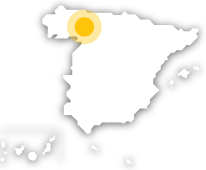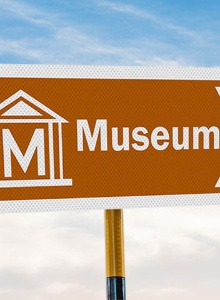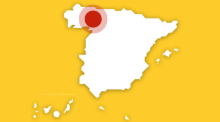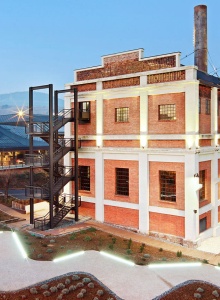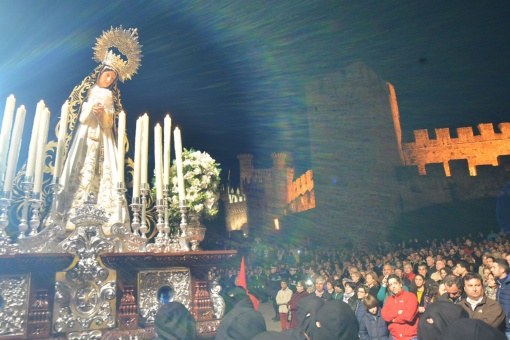Ponferrada, capital of the region of El Bierzo, is one of the major staging posts on the Pilgrim's Road to Santiago de Compostela as it passes through the province of León. The historic quarter of this town sits below an imposing castle built by the Knights Templar.
In 1178, the King Fernando II of León placed this flourishing settlement under the custody of the Order of the Temple. The Knights Templar used the site of a primitive Roman fortress to build a castle in which they settled and which, at the same time, protected the passing pilgrims. This favoured demographic growth and led to the commercial development of the area.
The Castle
The Castle rises above the river Sil, dominating the city's historic quarter. Construction began on this medieval fortress with a polygonal structure towards the end of the 12th century. The entrance is on the south side, over a drawbridge spanning the moat. The main façade, meanwhile, is flanked by two large towers joined by a double semicircular arch. Standing off a large interior courtyard are various rooms, such as the Armoury or the Stables, not forgetting its Keep and others like the Malpica, Cabrera, Malvecino, etc.
At the foot of the Castle is the historic quarter of the city, with entry along Calle del Reloj. It is on this street where the Clock Tower stands, built during the reign of Carlos I in the 16th century, on the site of one of the gates of the former walled enclosure.
Next to the Clock Tower is the Convent of the Conceptionist Mothers. The building, on two floors, was erected in masonry by Francisco Samper, beginning in 1565. Particularly noteworthy is its façade, which features a vaulted niche with the image of the Purísima Concepción.
The end of this streets leads into the Plaza de la Encina, a traditional site of commercial activity. The Basilica de la Encina stands on the square and is one of the most outstanding religious buildings in the city. The church was built in the Renaissance style in 1573, while its baroque tower dates from later, from 1614. Inside, as well as the carving of the Virgen de la Encina, some reredos can be seen, among which the high altar is outstanding, the work of Mateo Flores in the 17th century.
At the bottom end of the historic quarter is the Hospital de la Reina, Renaissance in style, and the baroque church of San Andrés, which houses a Christ of the Knights Templar.
Museum of El Bierzo
It is worth visiting the Museum of El Bierzo, located in Calle del Reloj, in the building which was the former prison. Its facilities provide an introduction to the historic legacy of Ponferrada and the surrounding area displaying objects, tools and various works of art. The ground floor of the museum, dedicated to primitive settlements from the Lower Paleolithic age to the end of the Roman period, has a collection of stone tools, ceramics and other pieces. Outsanding from this period is a room devoted to the hill-forts, small pre-Roman settlements which were established in large numbers all over the area.
From the Middle Ages, the Museum preserves a valuable collection of sculpture, paintings and precious metalwork. The socio-economic changes experienced in El Bierzo in recent centuries, and especially the development of the mining industry, are also featured in this exhibition. The tour of the museum's premises ends in rooms relating to different aspects of the region such as the landscape, the fauna and the flora.
On the outskirts of Ponferrada is another of its architectural gems. This is the Church of Santo Tomás de las Ollas, a Mozarab temple built in the 10th century, rectangular in shape and with a Romanesque main front (12th century). Particularly noteworthy inside is the Main Chapel, an original work formed by nine horseshoe arches crowned by an irregular polygon of eleven sides.
Surrounding area and gastronomy
The surrounding area of Ponferrada has other places of interest to visit. One of them is the Monastery of San Pedro de Montes, whose construction dates from the 7th century, although it was remodelled on several occasions. Outstanding is the monastic church, which is Romanesque with subsequent 18th-century additions. It has a basilica plan, with three naves and houses several reredos and images inside.
Several kilometres to the south is the church of Santiago de Peñalba, belonging to the monastery founded by San Genadio in the 9th century. The temple, built in the Mozarab style, has a single nave with two adjoining chapels connected by horseshoe arches.
Ponferrada is on the route of the Pilgrim's Route to Santiago de Compostela, which crosses the province of León and passes places such as Hospital de Órbigo, Astorga, Cacabelos, the Monastery of San Miguel de las Dueñas or Villafranca del Bierzo. This last place provides the option of staying in the Parador de Turismo.
The province of León has in its territory one of the main natural attractions of the entire Cantabrian mountain range: the Picos de Europa National Park, a space which is shared with Asturias and Cantabria. The walk through the Cares gorge or the Naranco de Bulnes mountain offer some of the most spectacular landscapes in the Picos de Europa.
Las Médulas, declared a World Heritage Site, form a singular landscape of reddish earth which is a reminder of the extraction of gold carried out in the area by the Romans from the 9st century AD.
As the capital of El Bierzo, Ponferrada is a magnificent shop window for the region's main recipes. Outstanding is the botillo, thick pork sausage marinated and smoked and served with "cachelos" (boiled potatoes) and vegetables. This dish must be washed down with Bierzo wines, which have their own Designation of Origin standard.

